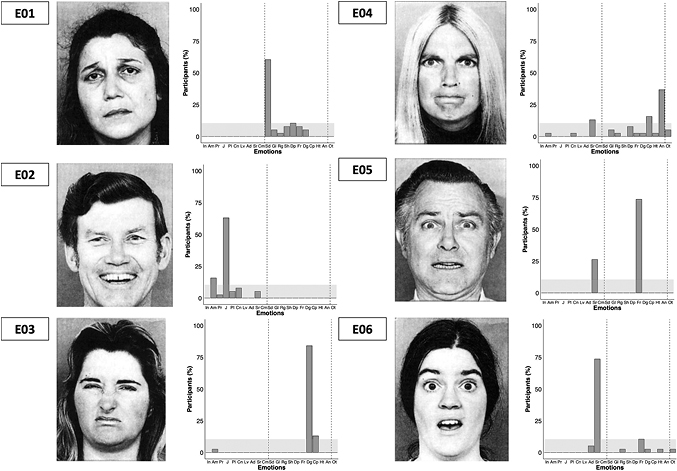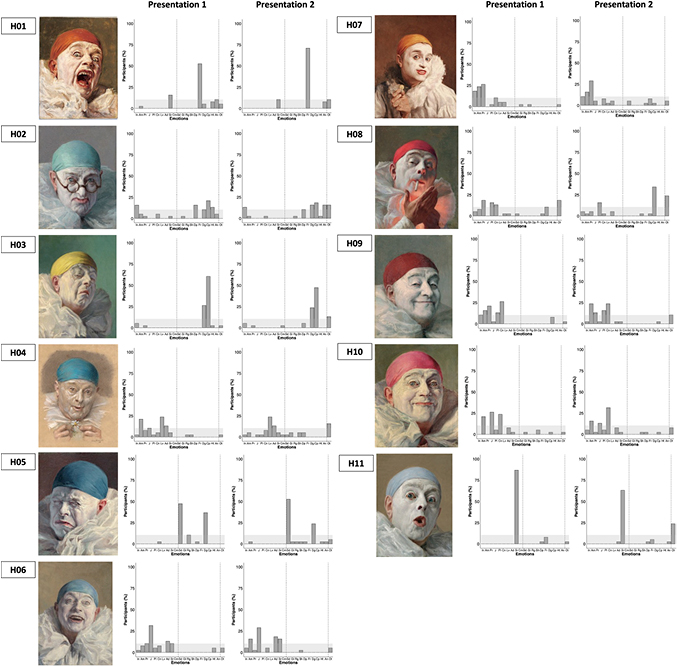
Introduction:
Researchers often study recognition of single emotions. Realistic faces, however, display several emotions in quick sequence or at the same time (mixed emotions). This likely causes interindividual differences in peoples’ reactions to the same situations and stimuli. We studied such differences using 11 self-portraits painted by Armand Henrion (1875–1958), in which he depicts himself as a Pierrot clown displaying different affective states. Thirty-eight adult participants (15 men) saw the self-portraits twice (one brief, then one unlimited presentation). After the first brief presentation (1–2 s), participants (i) selected the most prominent emotion (out of 20) and (ii) rated the intensity of this emotion. After the second unlimited presentation, participants performed the same selections and ratings before describing what could have caused the facial expression (qualitative data). Results confirmed that Armand Henrion’s self-portraits display mixed emotions: participants selected diverse emotions, sometimes differing in valence. Participants selected comparable emotions between presentations but rated them as more intense the second time. The qualitative answers complemented the selected emotions. For instance, when some participants chose ‘disgust’, others chose ‘sadness’ for the same self-portrait. The qualitative answer matched this choice, indicating that the character either “ate or drank something they don’t like” or “lost something or someone”. The researchers conclude that Armand Henrion’s self-portraits provide a promising set of facial stimuli to investigate mixed emotions. Each self-portrait displays diverse emotions of varying intensities and they are realistic because they could all be linked to possible situations.
The researchers recruited 38 adult volunteers (15 men, Mage = 23.5 years, SDage = 2.9 years, range = 20–31 years). Some participants (n = 26, 11 men) were first-year psychology students at the University of Lausanne and were compensated with course credit. The remaining participants were recruited via personal contact and participated voluntarily without remuneration. Participants’ vision was normal or corrected-to-normal with glasses or lenses. No participant was colour-blind, as verified using the Ishihara colour vision test (Ishihara, 1993). The study was conducted in Switzerland using the French language.
Personal Reflection:
This article gives a good perspective on how to analyze the emotions revealed by a picture more effectively from a scientific research angle. It takes inspiration from the artwork self-portraits painted by Armand Henrion to analyze the emotions exhibited by expressions. I agree with this article that we often focus too much on recognizing and shaping a single emotion, but in real situations humans often display multiple emotions quickly or simultaneously. As the title of the article says, a picture is worth a thousand words. Emotions, being a very subjective feeling, may be understood completely differently by each person from the same picture, which is a manifestation of mixed emotions. Also because of the subjective characteristic of emotions, I was surprised that this article could make such a subjective scientific analysis.
Reference:
Müller, L., Mohr, C., Cano, C., Camenzind, L., Soborun, Y., & Jonauskaite, D. (2022). A picture is worth a thousand words: Emotion recognition and qualitative impressions of Armand Henrion’s self-portraits displaying mixed emotions. Art & Perception, 10(4), 334–360. https://doi.org/10.1163/22134913-bja10041




